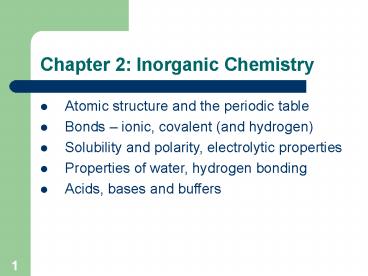Chapter 2: Inorganic Chemistry - PowerPoint PPT Presentation
Title:
Chapter 2: Inorganic Chemistry
Description:
Chapter 2: Inorganic Chemistry Atomic structure and the periodic table Bonds ionic, covalent (and hydrogen) Solubility and polarity, electrolytic properties – PowerPoint PPT presentation
Number of Views:199
Avg rating:3.0/5.0
Title: Chapter 2: Inorganic Chemistry
1
Chapter 2 Inorganic Chemistry
- Atomic structure and the periodic table
- Bonds ionic, covalent (and hydrogen)
- Solubility and polarity, electrolytic properties
- Properties of water, hydrogen bonding
- Acids, bases and buffers
2
Atomic structure
- Number of protons
- Number of protons number of neutrons
- (isotopes vary in neutrons)
- Equal to of protons
- Row on periodic table
- Group (1-8)
- (active bonding electrons)
- Atomic number
- Atomic mass
- Number of electrons
- Electron energy levels
- valence electrons
3
(No Transcript)
4
Bonds involve valence electrons
- Metals tend to transfer electrons
- Nonmetals tend to take electrons when bonding
with metals - Nonmetals tend to share electrons when bonding to
other non-metals
- Ions charged atoms due to the gain or loss of
electrons - Ionic bonds cations and anions
- Covalent bonds shared electrons
5
Covalent and Ionic bonds
6
Ionic bonds
- Metals form cations when they lose valence
electrons - Nonmetals form anions when they gain valence
electrons - Generally are hydrophilic, dissolve in water,
form electrolytes - Ionic equations show the ions into which they
separate
7
Covalent bonds
- Shared electrons
- Non-metals to non-metals
- Do not form ions in solution
- May be polar or non-polar covalent
- Covalent bonds are stronger than ionic bonds
- CHNOPS compounds of living things (organic) are
covalently bonded
8
H2O is a polar molecule, covalently bonded but
with an unequal distribution of shared electrons
9
Water is the versatile solvent
The hydrogen bonds between hydrogen and oxygen
cause unique properties of water
10
Polar solvents dissolve polar solutes
- Sugar dissolves in water
- Salt dissolves in water
- Only ionic compounds form electrolytes in water
11
Nonpolar solutes do not dissolve in polar
solvents (water)
- Salad oil
- Oil
- Gasoline
- Vegetable shortening
- butter
12
Acids, Bases, Buffers
pHyrion paper
- Acids release H in solution
- Bases release OH- in solution
- Buffers resist changes in pH
13
pH scale
14
Biological systems depend on buffers
- Narrow tolerances to changes in pH
- Acid rain alters pH of soils and aquatic
ecosystems - Limestone is used as a buffer in acidified lakes































